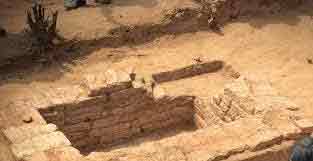Keeladi :- The Oldest Civilization Actually from India
The scene of “KEELADI” virtually set out a ‘back to the future’ glimpse for our cities. Keeladi also referred to as KEEZHADI is in the Sivaganga district of Tamil Nadu. It is a pre-Sangam (iron-age) hamlet draped in coconut grooves on the banks of river Vaigai, which is being unearthed and has grabbed eyeballs around the world due to the revelation of shreds of evidence of ancient civilization being present there.
The saga of “KEELADI” commenced resolving in the year 2015. The first three rounds of excavations were conducted by the Archaeological Survey of India and from the fourth to sixth rounds, the excavations were administered by the Tamil Nadu State Archaeology Department (SDA). The seventh phase is under its way.
The miniature potsherds were the underlying indicators that signaled that something peculiar existed underneath the crust. The second phase of excavation was the game changer as it heaved prominent hints regarding the presence of a Tamilian civilization which is correlative to what was cited in the Tamil literature.
Also Read:
- History of Cyclones
- History of Kohinoor Diamond – Everything You Should Know
- 5 Inventions: Remote Control, Wall Clock, Plastic, Fan & Typewriter
- GREATNESS OF QUEEN AHILYABAI
The findings from the Keeladi excavations provide differentperspectives in determining the oldest civilization.Some archaeologists postulate that Keeladi shares roots with the Indus Valley Civilization as both civilizations were exemplary in water management techniques. In contrast to this, other academicians affirm that the Vaigai Valley Civilization must have been the ancestor one. Just as other riverside civilizations vanished when the water resources ran out, Keeladi too would have declined due to the shift in course of Vaigai.
According to historians and epigraphists, Keeladi is extraordinary as it has amassed structures than other akin layouts. Moreover, the striking water management groundwork bespeakstheir skilled artistry, sophistication, and mastery in water management. Diverse graffiti on the walls, leisure items, brick structures, and proof of inward and outward trade suggest that the population was profoundly literate.

Tamil Nadu Archaeological Department’s report on the explorations of Keeladi developed the fact that urban civilization was prospering on the banks of the Vaigai river in Tamil Nadu in the 6th century BC. Hence, the Sangam Age of Tamil Nadu was evoked very prior that is from 300 BC and this disclosure has recast the conception of Indian history so far. Carbon dating methods confirmed Keeladi being three centuries older.
The findings precisely affirm that Keeladi had a civilization much senior and much cultured than any other Indo civilization. Still, numerous questions are unanswered about the chronological progression of the Keeladians and hence the state government has approached to proclaim five villages namely- Keeladi, Agaram, Manalur, Konthagai, and Pasiapuram as the Keeladi cluster. Consequently, much more unimaginable facts can be revealed. The Keeladi exhuming has provoked a healthy deliberation on the origin of Indian civilization as Keeladi has become a priceless piece of the gigantic geographic jigsaw puzzle.















































